Introduction
- Personality:
- First studies and theories appeared in the 19th century.
- Sigmund Freud:
- A pioneer in developing the theory of personality (Burger, 2014).
- Developed psychoanalysis (a specific approach to studying personality) (Engler, 2014).
- This project:
- describes the Freudian theory of personality;
- reveals controversies associated with the theory.
Despite the fact that people were always interested in studying personality, the first investigations of this aspect and theories appeared only in the 19th century. Sigmund Freud was among the pioneers of developing the theory of personality (Burger, 2014). Freud became known as the first personality theorist who developed the method of psychoanalysis as the basis for his theory and as a specific approach to researching the nature of an individual’s personality (Engler, 2014). The purpose of this project is to describe the Freudian theory of personality and focus on studying controversies associated with Freud’s theoretical views.
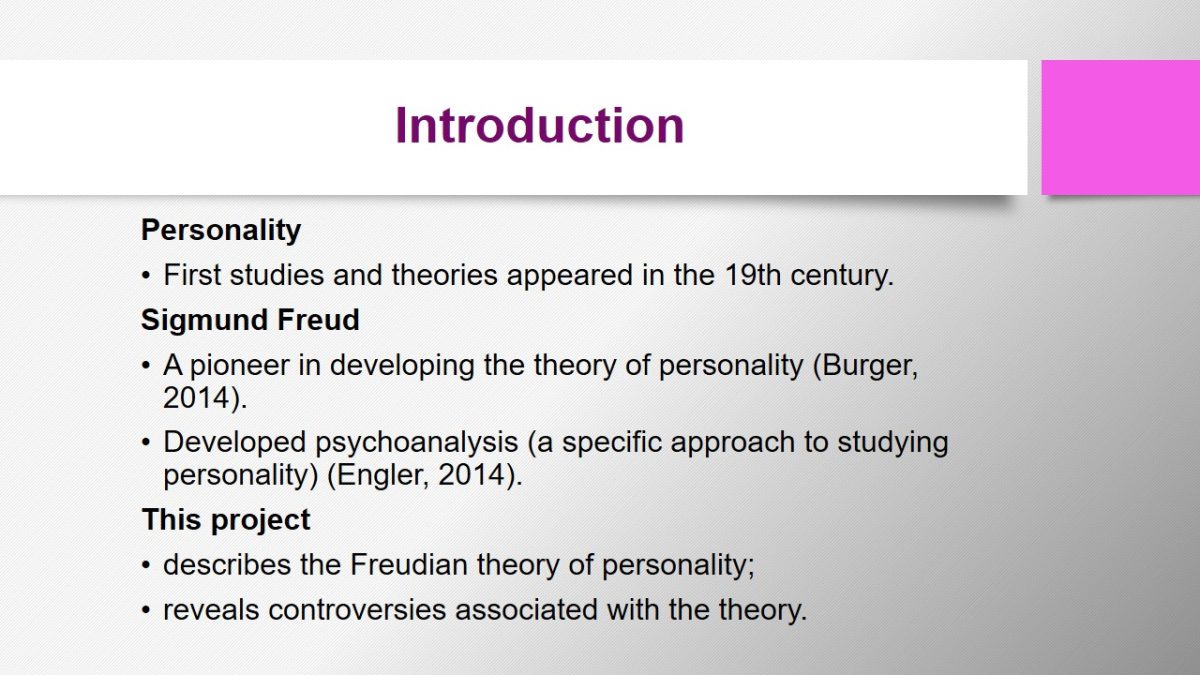
Reasoning for Selecting the Freudian Theory of Personality
- The Freudian theory of personality:
- the first formal theory of personality with assumptions and principles;
- based on multiple works written by Freud;
- highly criticized (Burger, 2014);
- the most acknowledged theory of personality;
- one of the most referred theoretical models in psychology (Schultz & Schultz, 2016);
- influenced almost all further theoretical views regarding personality.
The Freudian theory of personality is selected for being discussed in this project because it is the first formal theory of personality that was formulated with all its assumptions and principles. In spite of the fact that Freud as a neurologist and a researcher wrote multiple works on his theory of psychoanalysis, these views were highly criticized (Burger, 2014). Still, the Freudian theory of personality remains to be the most acknowledged theory in this field, and it requires the detailed analysis as it is one of the most referred theoretical models in psychology (Schultz & Schultz, 2016). This theory influenced almost all further theoretical views in the field of studying personality.
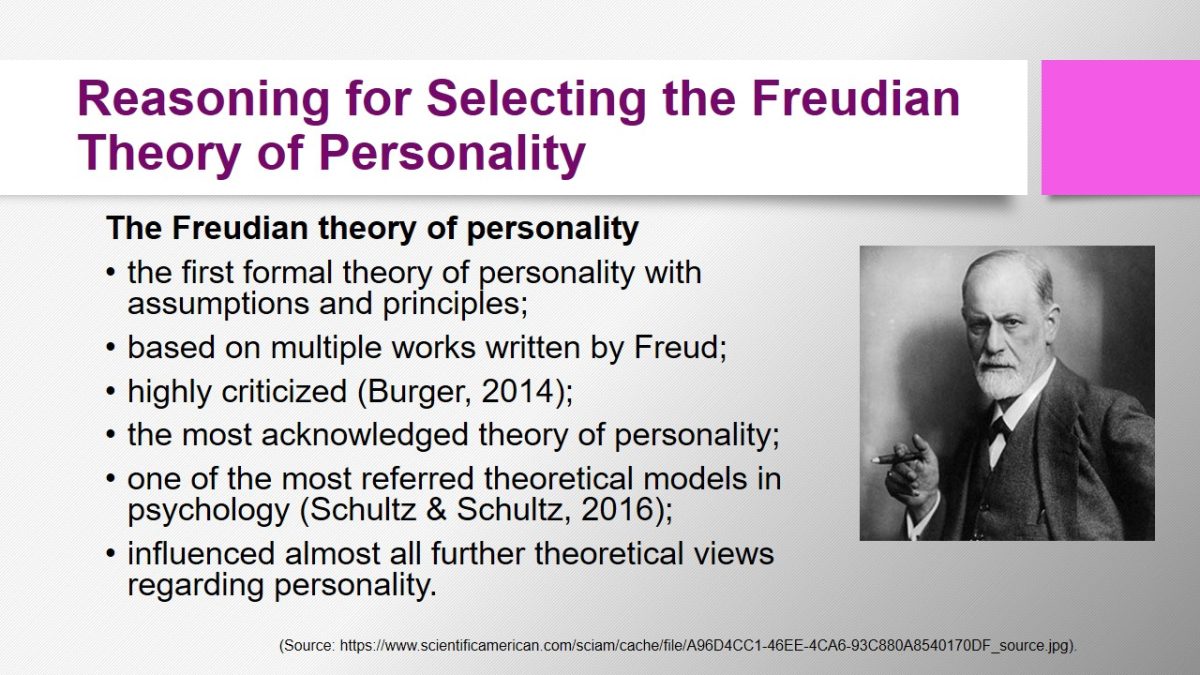
Freud’s Approach to Viewing Personality
- The Freudian theory of personality:
- a result of cooperation with Jean-Martin Charcot and Joseph Breuer;
- have roots in studying hysteria, using hypnosis (the case of Anna O.) (Burger, 2014);
- based on studying a free association approach and patients’ unconscious processes;
- three parts of personality;
- the unconscious significantly influences a person’s behavior.
The Freudian theory of personality became a result of the theorist’s cooperation with Jean-Martin Charcot, a neurologist, and later with Joseph Breuer, a physician. While working with Breuer, Freud became interested in using hypnosis and studying hysteria (Burger, 2014). The focus on studying alternative methods of treating hysteria referring to the case of Anna O. allowed Freud to introduce a free association approach. Later, Freud became concentrated on studying a patient’s unconscious processes, and this practice allowed him to formulate the key ideas of his theory: personality has three parts, such as conscious, preconscious, and unconscious, and the unconscious part can significantly influence a person’s behavior (Schultz & Schultz, 2016).
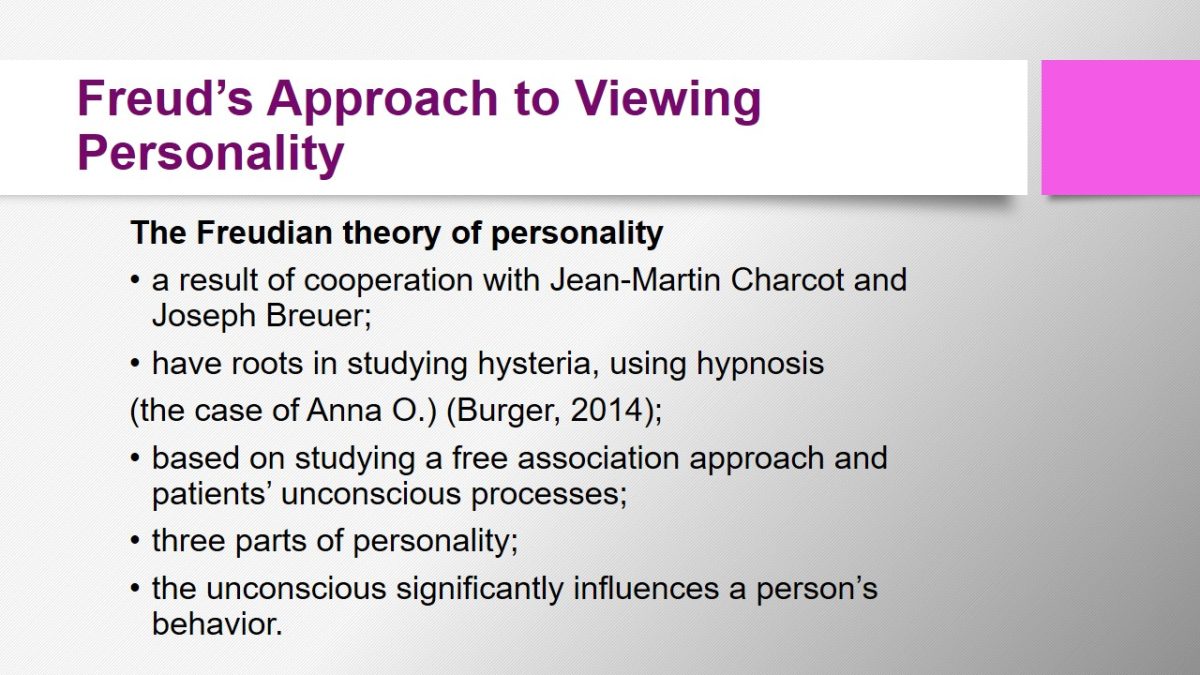
The Topographic Model
Personality:
- The conscious:
- an upper layer of the personality;
- thoughts and perceptions.
- The preconscious:
- a deeper layer;
- memories, fears, doubts, and knowledge.
- The unconscious:
- the deepest layer;
- motives, aggression, and hidden desires (Burger, 2014).
Personality is divided into three parts: the conscious, the preconscious, and the unconscious. The conscious is an upper layer of the personality that is represented by thoughts and perceptions of individuals. The preconscious is a layer that represents memories, fears, doubts, and knowledge that individuals are not aware of if they are not focused on these aspects. The unconscious represents the deepest part of the personality which is associated with individuals’ motives, aggression, and hidden desires (Burger, 2014). In spite of being hidden deeply, these aspects influence a person’s behavior and activities.
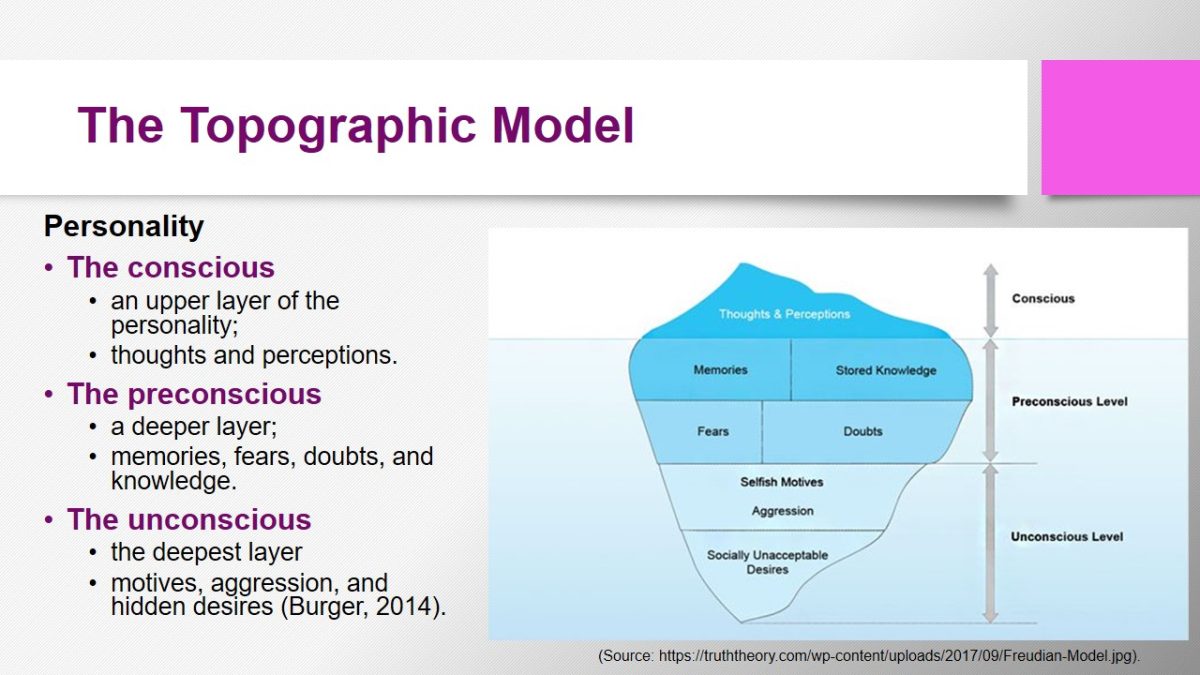
The Structural Model
Personality:
- The id:
- satisfaction of personal needs and desires;
- focus on pleasures, no identified limits or barriers.
- The ego:
- controls id impulses, desires, and thoughts;
- functions at all levels of the personality.
- The superego:
- a person’s morality and values (Burger, 2014);
- self-regulation and self-control.
The further development of the idea of personality led to the identification of the id, the ego, and the superego as parts of the personality. The id is associated with an individual’s satisfaction of personal needs and desires. The focus is on pleasures, and there are no identified limits or barriers. This part is associated with the unconscious. The ego is the part of the personality that controls id impulses oriented to satisfying basic needs, as well as other desires and thoughts, and it can function at all levels of the personality, including the conscious, the preconscious, and the unconscious. The superego is associated with a person’s morality and values (Burger, 2014). Thus, it is associated with an individual’s self-regulation and self-control at the highest ethical level.
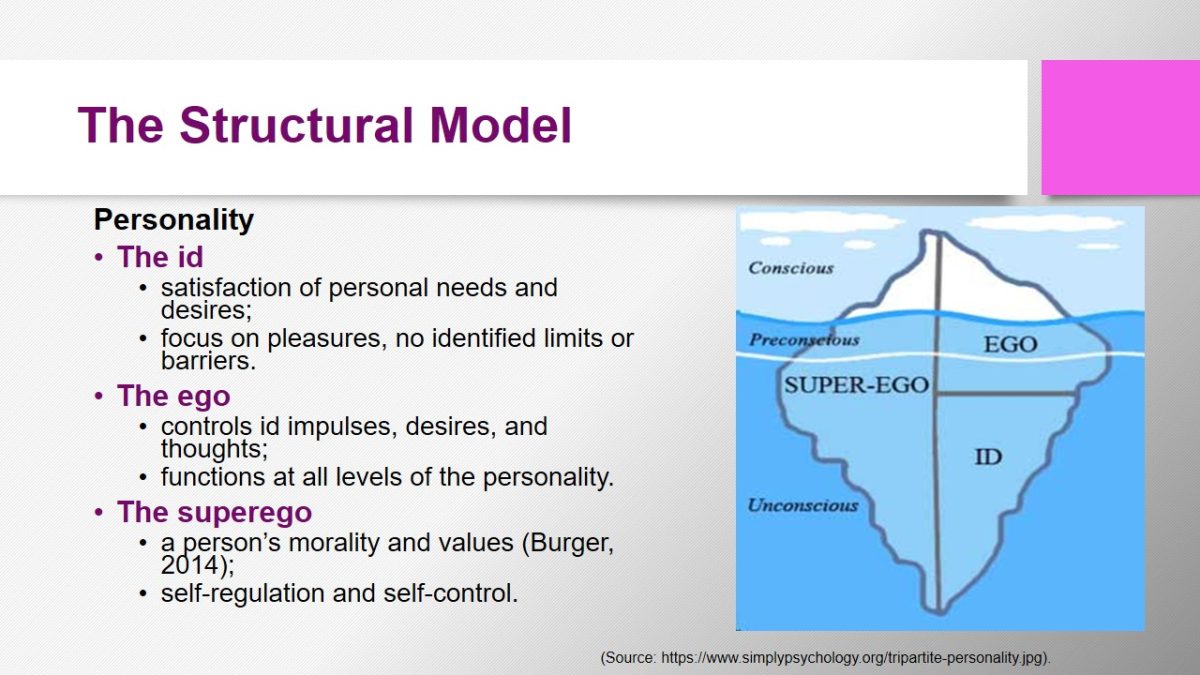
Instincts
Instincts = internal forces.
- Libido:
- sexual or life instincts;
- motivate pleasure-/satisfaction-oriented activities;
- motivate sexual behaviors;
- motivate activities associated with finding food and water (Engler, 2014).
- Thanatos:
- aggressive or death instincts;
- stimulate aggression, self-destructive behaviors, and socially threatening behaviors (Burger, 2014).
According to Freud, the activities of all parts of the personality are driven by instincts viewed as internal forces. There are two types of these instincts: sexual instincts (libido) and aggressive instincts (thanatos). Sexual or life instincts motivate a range of activities, including pleasure- or satisfaction-oriented activities, sexual behaviors, and activities associated with finding food and water (Engler, 2014). Aggressive or death instincts stimulate people’s aggression, self-destructive behaviors, and socially threatening behaviors (Burger, 2014).
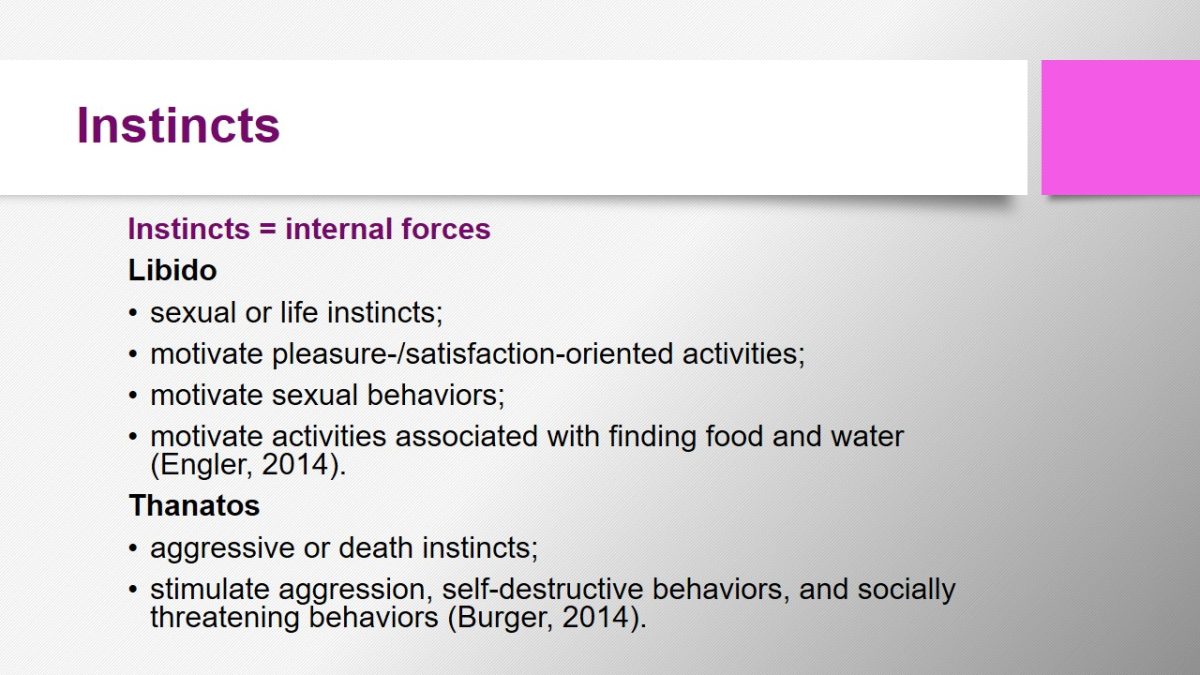
Defense Mechanisms
- Protect from traumatic experiences and painful memories.:
- Sublimation;
- displacement;
- repression;
- denial;
- intellectualization;
- reaction formation;
- projection;
- rationalization;
- undoing (Burger, 2014; Engler, 2014).
- Examples:
- Sublimation:
- using unconscious impulses for producing something new.
- Displacement:
- directing negative thoughts/actions toward another object.
- Repression:
- repressing negative experiences without letting them become conscious.
- Sublimation:
Freud stated that many traumatic experiences and painful memories can be hidden in the unconscious. To prevent them from becoming the part of the conscious and affecting individuals’ thoughts and activities, people use defense mechanisms that protect them from anxiety. These mechanisms include sublimation, displacement, repression, denial, intellectualization, reaction formation, projection, rationalization, and undoing among others (Burger, 2014; Engler, 2014). There are some examples and explanations. Sublimation is associated with using unconscious impulses for producing something new or for exercising. Displacement is associated with directing negative thoughts or actions toward another object. Repression is related to repressing negative experiences without letting them become conscious.
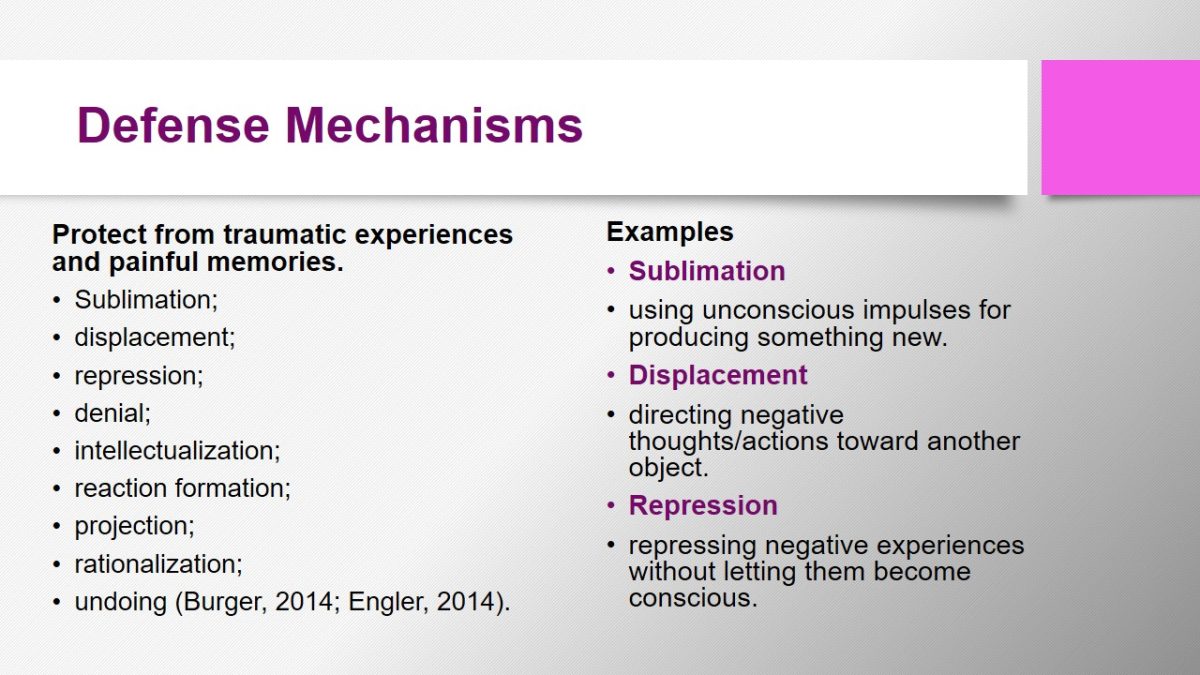
Stages of Development
- Associated with childhood;
- influence the adult life.
- Oral stage (birth-18 months):
- the mouth and lips;
- dependence on others;
- oral satisfaction.
- Anal stage (18 months-3 years):
- the anus;
- importance of toilet training.
- Phallic stage (3-6 years):
- the penis and clitoris;
- the Oedipus complex (Burger, 2014).
- Latent stage (6 years-puberty):
- sublimation of sexual instincts.
- Genital stage (adolescence-adulthood):
- sexual identity;
- sexual intercourses (Engler, 2014).
Freud identified several psychosexual stages of development that are associated with an individual’s childhood, and they also influence his or her adult life. These stages are oral, anal, and phallic ones. While overcoming these stages, children can experience problems or fixate their energy on some stages without moving to others.
At the oral stage, which lasts from the birth to 18 months, erogenous zones are the mouth and lips. Those persons who fixate on this stage are usually dependent on others and focus on the oral satisfaction.
At the anal stage, which lasts from 18 months to three years, an erogenous zone is the anal region, and successes in toilet training can influence the development of personality.
At the phallic stage, which lasts from three to six years, erogenous zones are penis and clitoris (Burger, 2014). Freud explained the Oedipus complex with reference to this stage and children’s attraction to their parents. The effective resolution of this complex is important for the further development.
There are also latent and genital stages. The latent stage is associated with sublimating sexual instincts, and it lasts from six years till puberty. The next stage is genital, and it covers adolescence and adulthood, when a person resolves the issue of his or her sexual identity (Engler, 2014).
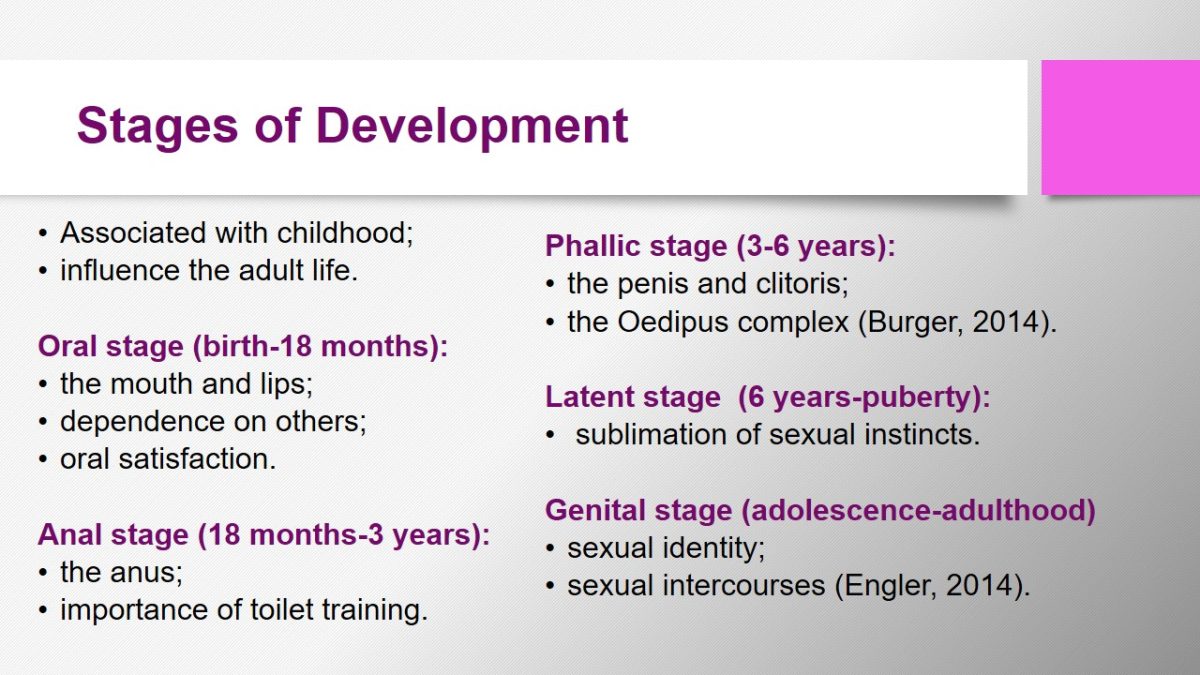
Psychoanalysis
- A unique system of psychotherapy;
- a complex and prolonged process.
Goals:
- access the unconscious material;
- make it conscious;
- overcome complexes, unsatisfied desires or needs.
Psychoanalysts:
- help patients overcome problems;
- develop mechanisms to address id impulses (Burger, 2014);
- patients can resist psychoanalysts’ efforts.
Freud’s psychoanalytic theory is based on a unique system of psychotherapy. The key goal of this approach is to access the unconscious material and make it conscious in order to overcome complexes and problems associated with unsatisfied desires or needs. Psychoanalysts cooperate with patients to help them overcome the revealed problems and develop the mechanisms for the ego to address id impulses (Burger, 2014). During the therapy, a patient can resist a psychoanalyst’s efforts because of the revealed hidden material. Psychoanalysis is a complex and prolonged process that consists of multiple therapy sessions.
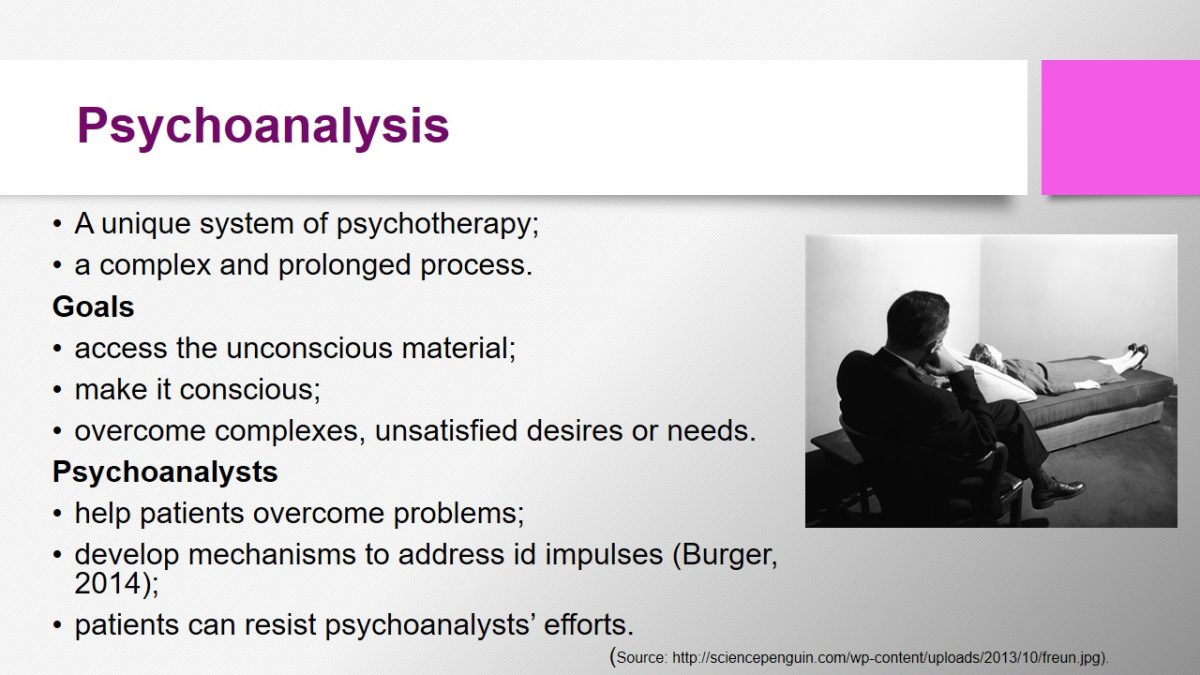
Tools of Psychoanalysis
- The focus on dreams:
- id impulses;
- hidden desires;
- psychoanalysts help decode symbols from dreams (Burger, 2014).
- Free association:
- patients name things from minds without controlling.
- unblocks ideas repressed by the ego (Schultz & Schultz, 2016).
- Hypnosis
- used to bypass the ego;
- access the unconscious.
- Additional tools: projective tests, the Freudian slips, interpretation of symbols.
Freud’s psychoanalysis depends on getting the material from the unconscious. In order to help patients reveal their unconscious desires and views, the theorist proposed to use such approaches as the focus on dreams, a free association tool, and hypnosis (Burger, 2014). According to Freud, dreams represent id impulses and hidden desires, and a psychoanalyst’s task is to help a patient decode symbols from dreams. Free association is another technique that helps a patient say all that appears in their minds without controlling. This technique is discussed as important to unblock ideas repressed by the ego (Schultz & Schultz, 2016). Hypnosis is also described as one of the tools of psychoanalysis, and it is used to bypass the ego and access the unconscious. Additional tools include projective tests, the Freudian slips, and the interpretation of symbols.
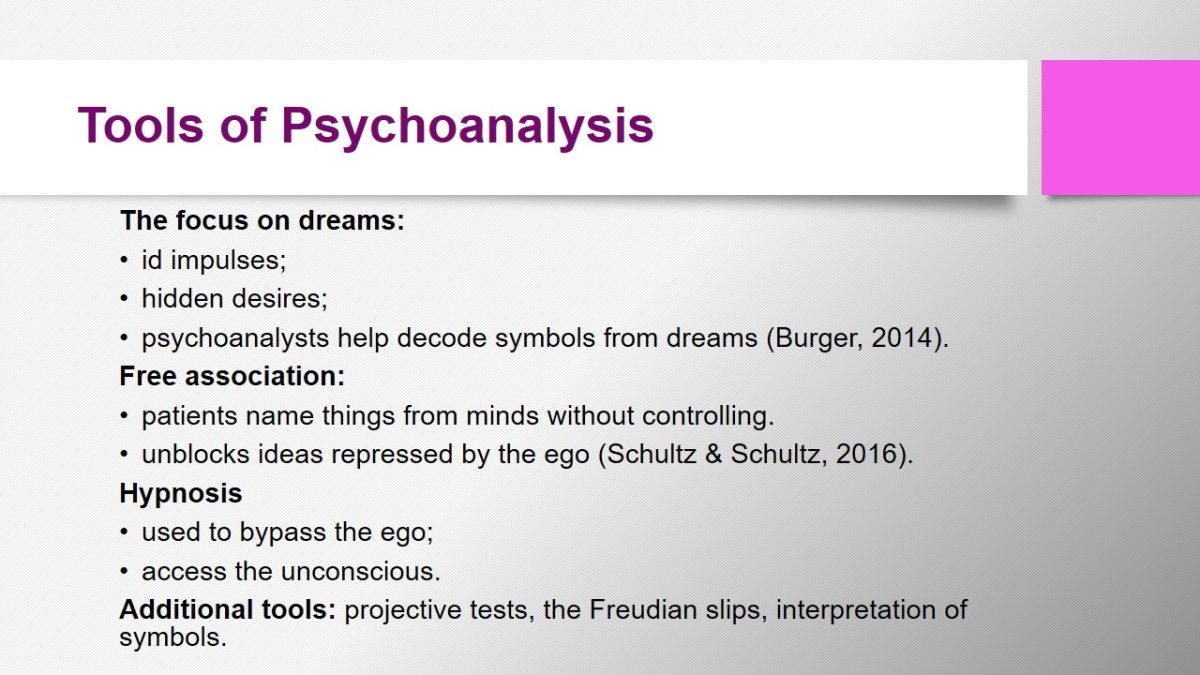
Projective Tests
- measure the material at the unconscious level;
- allow patients to describe what they observe;
- allow patients to react to provided images;
- allow for concluding about the unconscious (Burger, 2014);
- the validity of these tests is questionable.
Freud proposed to measure the material at the unconscious level with the help of projective tests. These tests allow patients to describe what they observe and react to the provided images. As a result, referring to patients’ responses, it is possible to conclude about the unconscious (Burger, 2014). In spite of the fact that the validity of these tests is questionable, they are actively used by psychoanalysts.
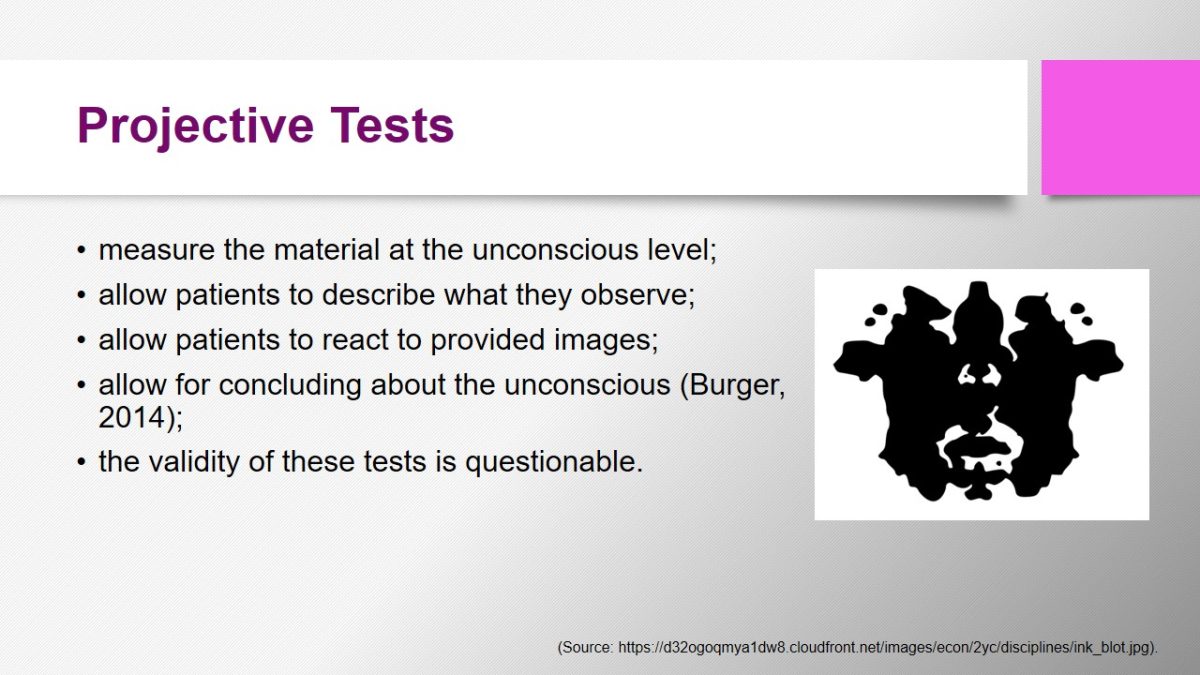
Strengths and Weaknesses of Freud’s Theory
- Strengths:
- Uniqueness;
- formality;
- the significant base of psychoanalytic concepts, principles, and assumptions;
- applicability;
- effective techniques (Burger, 2014).
- Weaknesses:
- The controversial focus on a human’s sexual nature;
- questionable reliability and validity;
- the hypothetical nature of some assumptions (Schultz & Schultz, 2016).
Strengths of the Freudian theory of personality are its uniqueness as this theory was the first one of that type; formality; the significant base of psychoanalytic concepts, principles, and assumptions; applicability. Today, this theory in the form of psychoanalysis is actively applied by therapists to practice (Burger, 2014). Those techniques that were proposed by Freud are actively used even today because of their effectiveness to focus on patients’ hidden motives. Weaknesses of the theory are associated with its controversial focus on a human’s sexual nature, questionable reliability and validity, and the hypothetical nature of some assumptions (Schultz & Schultz, 2016).
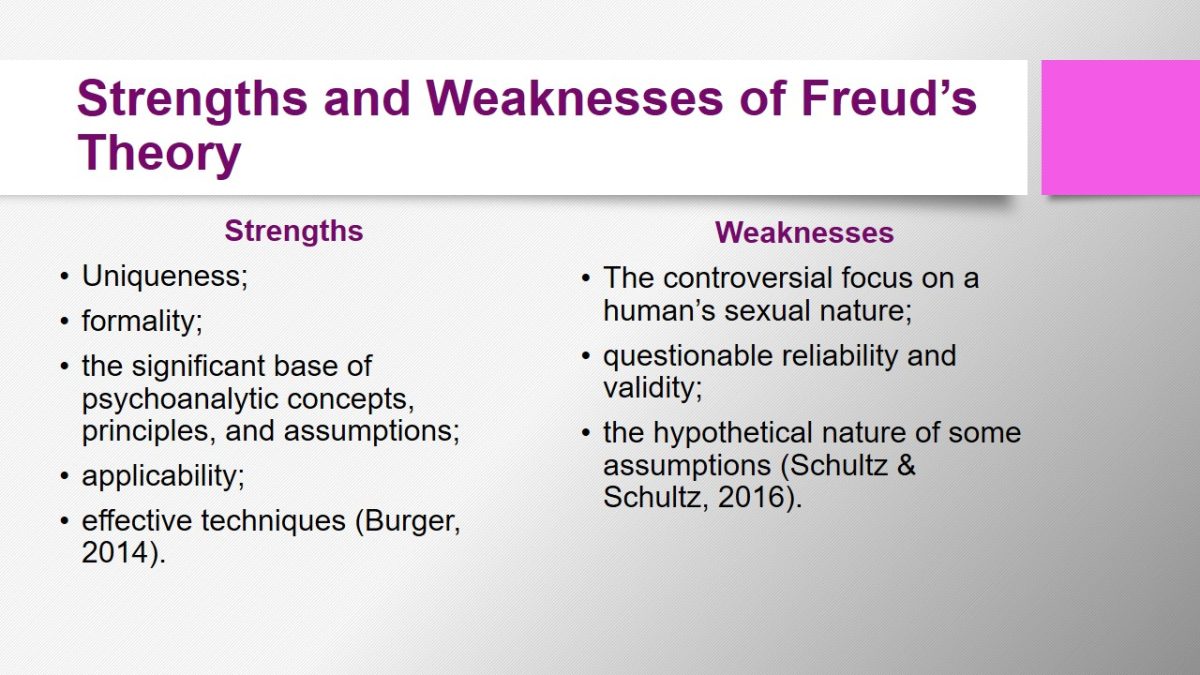
Conclusion
- Freud’s theory
- Controversial;
- provocative;
- influenced modern therapy;
- provided techniques and methods to study personality and explain its nature.
- Freud’s contribution to psychotherapy is considerable:
- the theorist’s ideas are reflected in multiple modern works;
- psychoanalytic approaches are used by practitioners.
In spite of the fact that Freud’s theory is viewed as rather controversial and provocative, its influence on therapy can hardly be overestimated. Freud drew the public’s attention to personality and its structure. Furthermore, he proposed the theory, techniques, and methods to study personality and explain its nature. From this point, the contribution of Freud to psychotherapy is considerable, and his ideas are reflected in the works of many other theorists. In addition, his psychoanalytic approaches are followed by practitioners.
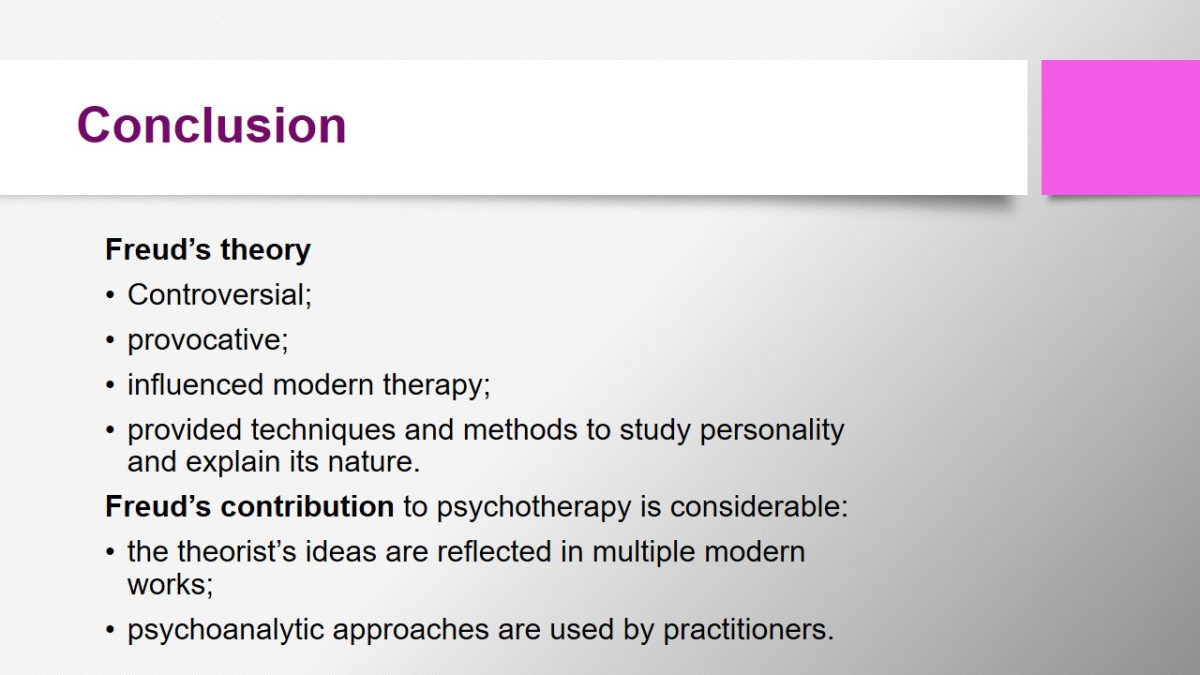
References
Burger, J. M. (2014). Personality (9th ed.). Stamford, CT: Cengage Learning.
Engler, B. (2014). Personality theories: An introduction (9th ed.). Belmont, CA: Wadsworth Publishing.
Schultz, D. P., & Schultz, S. E. (2016). Theories of personality (11th ed.). Boston, MA: Cengage Learning.